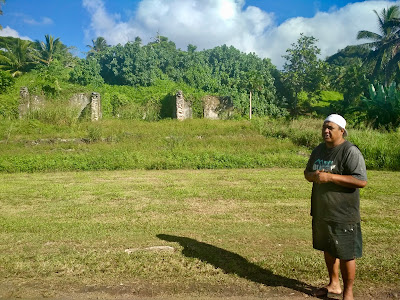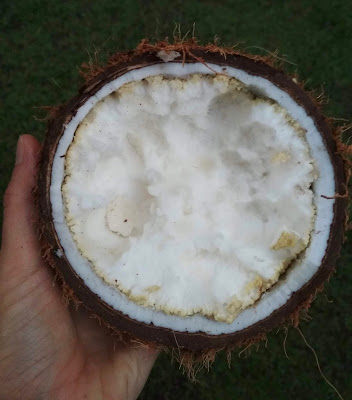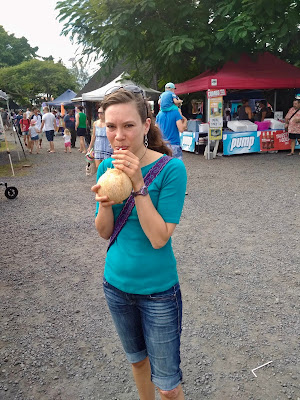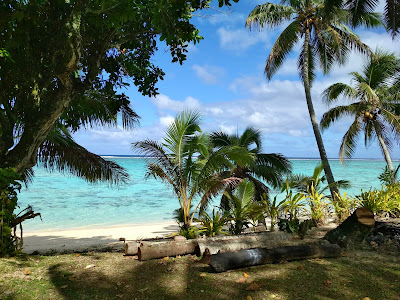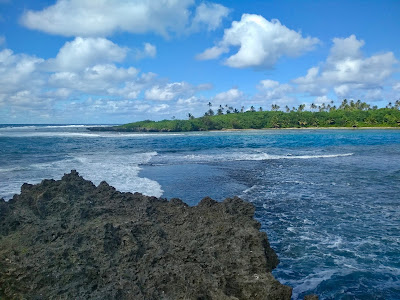Whenever we go to a new place, we like to learn about the local culture, and do our absolute best to be conscientious tourists. We weren't always sure of the best ways to do that in Rarotonga, because it felt like there were more tourists than locals on the island, and everything seemed so dependent on tourism. But we did our best, and we did learn a lot about the local culture, which was wonderful. It would be ridiculous to try to share it all with you, but I've selected some highlights.
On our Jungle Quad Adventure, our guide told us about this tree, called an Au Tree. It is used for many medicinal purposes, and our guide showed us how you can mash up its leaves in your hand and after just a minute, you can squeeze out liquid, which is very helpful if put on cuts or sores.
This is our guide, who also told us about this ruin. Apparently, a missionary came here and started constructing a church. The local leaders were supportive of this, until they found out that they were also building a crematorium behind the church. It is a very important part of their belief system that people return to the earth after they die, and so cremation is inappropriate to say the least. The church was therefore never completed on this site, although the missionary did find another location where the local leaders allowed his church and crematorium. It's sad, but unsurprising, to hear that even after realizing that his practices were inconsistent with local beliefs, he still continued his plans.
On our first stop on the Progressive Dinner we went on, our host took us around to his backyard, and showed us lots of interesting things, including this above-ground umu. An umu is an earth oven, where traditionally they would dig down, make a fire, put volcanic rocks on top, and once they were hot, cook their food wrapped in banana leaves. The banana leaves turn from green to brown during the cooking process, and keep the food nice and moist. Our host told us that they discovered that they could do the same thing with a heavy metal bowl inside this chemical container, and they're enjoying using that as well as the two underground ones they have. It reminded me of living with the Lubicon Cree tribe in Northern Canada, where we often saw traditional practices mixed with a "make use of whatever comes your way" attitude, resulting in very similar mashups.
Our host then showed us a way that coconuts are used. You take a coconut that has sprouted a new tree, bury it on the beach, and then cut the sapling off. The tree knows it will need to regrow, and so it puts more energy into creating food for the sapling, which is the flesh inside the coconut itself. If you do this over and over, the coconut gets more and more full and delicious, ending up, after multiple cuttings, like candy.
He said that they wouldn't usually break one open before cutting it several times, but he wanted to show us the process. It's hard to see in the picture, but there is a metal stake sticking up from the ground, which he used to break open the outer shell.
Underneath are hairy fibres called husks, which he pulled away. A coconut you would buy in the store has the outer shell and the husks removed, but he said once you get rid of those, it can't grow, so you'd always plant them whole. He seemed a bit sad to have used this one up in the demonstration, depriving it of its potential to grow.
(I apologize for the blurry picture, but it was getting dark. Also, on a side note, there were lots of chickens around, and they seemed to be competing for the best places in the trees to roost for the night, because they were being rather boisterous, making it hard to hear him.)
When the broke open the inner shell, it looked like this. We got to taste the foamy stuff in the middle, which was interesting and mild in both texture and taste. Apparently, as you cut off the sapling more times, that inner part gets harder and sweeter, more like candy.
This was our host at the second location for the Progressive dinner. All three of our hosts talked about the importance of owning land on Rarotonga, and how difficult it is. Our first two hosts had married someone who owned the land they now lived on, and the third's family had been there for generations. Only natives of Rarotonga are allows to own land, so even Cook Islanders from the other 14 islands can't buy land there. This was on our last night, and it made me think of a nice lady we met who had been living on Rarotonga for 30 years, but was originally from Australia. She must either be renting or have married into a native family.
Our resort has a weekly "Island Night" where you can sample traditional Rarotongan food (see my last post) and learn about traditional dances. This man was the host of the evening, and as he walked by our table, he stopped and asked if we wanted a picture, which of course we did. His traditional clothes were amazing.
The dances and music were beautiful, although we were disappointed to see a "Discover Paradise" advertisement for our resort centre stage behind the performers. Commercialism detracts greatly from the celebration of a culture, and that was not the only thing about the evening that felt much less authentic than we would have liked. We tried to focus on the music and dancing and not worry about the rest. If we ever go again, we will find a tradition performance in a more authentic setting if we can. (We should have known this already, but I guess we just didn't think it through.)
The women dancers did lots of hip and arm movements, and the men did more with their legs and especially their knees. The traditional dance outfits were beautiful, especially the women's headdresses. Many parts are made from various parts of the coconut and coconut tree, as well as from flax (as is also true in NZ).
You can see a bit in the background on the right of the wooden pa'u, which are traditional drums. Drums are the central sound in all the music we heard, with ukuleles joining in with the melody. In almost every song, the beat started out reasonable slowly, and there was often singing along with the ukulele melody. Then, about 2/3 through, the beat would suddenly become very fast and the drums would be proportionately much louder. The dancers' movements would become much faster and more staccato. This would continue for the rest of the song. It was fascinating to watch the change, and both styles were beautiful.
If you click on it to make it bigger, you should be able to read these plaques, which we noticed at the Punanga Nui Market, and which celebrate the ongoing positive relations between Rarotonga and NZ.
This is Tuoro: Nga'i Reranga Varua (Departure Point of Spirits). It is locally known as Black Rocks. According to the plaque up by the road, "It marks the boundary between the districts of Te-Au-o-Tonga and Puaikura. The abundant black rock in the area, from which it derives its English name, is basalt. It is estimated to be 1.9 million years old.
"Tuoro" means to proclaim, or to challenge by calling out loudly to, as a sentry who challenges anyone approaching. Tuoro is believe to be the place where spirits of the dead leave Rarotonga. Those spirits ascend a pua tree and leap from it to commence their journey back to their ancient homeland, Avaiki, to the west. Similarly, the Māori people of Aotearoa (NZ) believe that Cape Reinga, in the North Island, is the departure point for the spirits of the Māori people to Hawaiki."
Tuoro is a very beautiful place, and it was lovely to explore. We went past it at dusk (when the first picture was taken), and then I went back the next day to explore further. When I got there, a person was flying a kite shaped like a bird from the top, and I found that very poetic, because it was like spirits taking off for Avaiki. In several of the beautiful Māori pūrākau (legends) I read with my children, the spirits of characters take the form of birds. I don't know if the person flying the kite saw the symbolism or not, but it was a lovely moment for me.
This concludes my posts about Rarotonga. It was an amazing trip, and we both really enjoyed our time there. I don't know if we will go back, as there are so many other new places to explore, but it is certainly a very special place.

